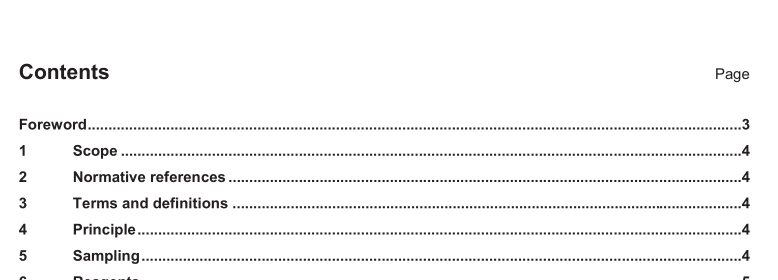EN 15922:2011 – Fertilizers – Extraction of soluble phosphorus according to Petermann at ambient temperature

1 Scope
This document specifies the procedure for the extraction of phosphorus soluble in cold alkaline ammonium citrate.
The method is applicable for disintegrated phosphates exclusively.
2 Normative references
The following referenced documents are indispensable for the application of this document. For dated references, only the edition cited applies. For undated references, the latest edition of the referenced document (including any amendments) applies.
EN 1482-2, Fertilizers and liming materials — Sampling and sample preparation — Part 2: Sample preparation
EN 12944-1:1999, Fertilizers and liming materials and soil improvers — Vocabulary — Part 1: General terms
EN 12944-2:1999, Fertilizers and liming materials and soil improvers — Vocabulary — Part 2: Terms relating to fertilizers
EN 15475, Fertilizers — Determination of ammoniacal nitrogen
CEN/TS 15959, Fertilizers — Determination of extracted phosphorus
3 Terms and definitions
For the purposes of this document, the terms and definitions given in EN 12944-1:1999 and EN 12944-2:1999 apply.
4 Principle
Extraction of phosphorus at ambient temperature about 20 °C with an alkaline solution of ammonium citrate (Petermann’s solution) under the specified conditions.
5 Sampling
Sampling is not part of the method specified in this document. A recommended sampling method is given in EN 1482-1.
Sample preparation shall be carried out in accordance with EN 1482-2. Grinding of the laboratory sample is recommended for homogeneity reasons.
6 Reagents
6.1 Water, distilled or demineralized having the same characteristics as distilled water.
6.2 Petermann’s solution
6.2.1 Characteristics of the Petermann’s solution
citric acid (C 6 H 8 O 7 . H 2 O): 173 g/l;
ammonia: 42 g/l of ammoniacal nitrogen;
pH between 9,4 and 9,7.
6.2.2 Preparation from diammonium citrate
Dissolve 931 g of diammonium citrate (molecular mass 226,19) in about 3 500 ml of water (6.1), in a 5 l standard flask. Stand in a bath of running water, mix and cool and add in small amounts ammonia. For example, for d 20 = 0, 906 g/ml.corresponding to a level of 20,81 % by mass of ammoniacal nitrogen, it is necessary to use 502 ml of ammonia solution. Adjust the temperature to 20 °C, make up to volume with water (6.1) and mix.
6.2.3 Preparation from citric acid and ammonia Dissolve 865 g of citric acid monohydrate in about 2 500 ml of water (6.1) in a container of about 5 l capacity. Place the container in an ice bath, and add in small amounts, shaking constantly, ammonia solution using a funnel, the stem of which is immersed in the citric acid solution. For example, for d 20 = 0, 906 g/ml.corresponding to a level of 20,81 % by mass of ammoniacal nitrogen, it is necessary to add 1 114 ml of ammonia solution. Adjust the temperature to 20 °C, transfer to a 5 l standard flask, make up to the mark with water (6.1) and mix.
6.2.4 Checking of the ammoniacal nitrogen content Transfer 25 ml of the solution into a 250 ml standard flask and make up to volume with water (6.1) and mix. Determine the ammoniacal content on 25 ml of this solution according to EN 15475. If the solution is correct, an amount of 15 ml of c = 0,25 mol/l H 2 SO 4 shall be used.
EN 15922:2011 – Fertilizers – Extraction of soluble phosphorus according to Petermann at ambient temperature